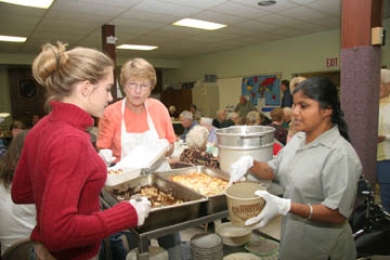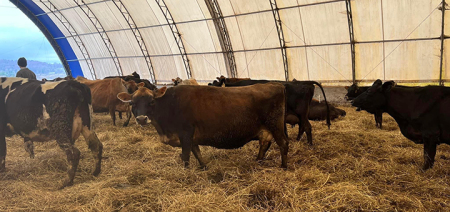Special Report: Sometimes, The Cupboard Is Bare
Published:
September 7th, 2007
By:
Jessica Lewis

Each week nearly 4 million people in the United States are accessing emergency food pantries (EFPs) to help provide their families with the basic food they need to survive. In New York state, more than 500,000 people are served on a weekly basis, but with a high demand for services and small amount of funding, many of the food pantries in Chenango County are finding it difficult to provide the food that is needed.
According to the Chenango County Census Bureau in 2004, 13.4 percent of Chenango County residents – approximately 7,000 people – were living below the poverty level.
According to Amalia Swan from the Food Bank of Central New York, in a ten month period last year, the 19 food pantries funded through the Food Bank served 574,000 meals in Chenango County alone.
“The food bank provides food and funding to food pantries, soup kitchens and senior centers throughout the area,” Swan said. Funding for the programs is provided through the Department of Health’s Hunger Prevention and Nutrition Assistance program. Area food pantries must apply for grants, and money is distributed based on the number of people served at that location. In rural areas, this can be difficult, since the number of people served can be low compared to other more populated areas.
“At times the agencies face a lot of difficulties. We’re seeing more agencies having a hard time staying open,” Swan said. “We don’t want any of the pantries to be without food.”
While Swan pointed out that there is always a panic to find enough food around the holiday season, in reality every day is an emergency.
Cortland-Chenango Rural Services is one area agencies that provides much more than just food pantry services. The program, run by Sister Kathleen Heffron, provides a clothing store, free school supplies, a farmers market and offices for other agencies, such as Child Health Plus, Food Stamps Outreach and WIC.
“We see a lot of people from both counties,” Heffron said. Cortland-Chenango Rural Services, located in Cincinatus, attempts to help families help themselves, by providing a community garden, where families can plant and pick their own food. The agency also provides emergency services, if a family is in dire need for food or gas, they do their best to help.
The agency also offers a food fence program. Families pay $15 at the beginning of the month, and get more than $30 worth of food at the month’s end. “That’s how most people plan to stretch their budget,” Heffron said. “All the food is fresh, and it reduces the load on the actual food pantry.” Anyone in the 11 Cortland and Chenango towns serviced by the agency can participate in the food fence program. “If you eat, you qualify,” Heffron said.
According to Heffron, the agency is in good standing. “We have no problem as far as food is concerned.” She explained that the program is funded by the United Way, and food comes in from local donations as well as from area churches.
Heffron said the need increases and decreases throughout the year, as more families grow some of their own food during the summer months. “This month there’s been a pick-up in need, which traditionally occurs when kids are getting ready to go back to school,” Heffron said. “With the high food prices, and fuel prices, I can’t imagine what winter is going to be like.”
The New Berlin Food Pantry has also seen an increased need in the last month. According to Esther Doty, the program manager, the agency served a total of 378 meals in the month of June, and a total of 1,404 meals in July. “July was a busy month for us because the kids were out of school. It puts an extra burden on the food budget at home,” Doty said.
Doty has been working at the New Berlin Housing Authority for two years. “There seems to be more of a need all the time,” Doty said. The New Berlin agency, like many others, tries to aid people by not just giving out food, but by trying to supply people with the tools and techniques they need to become self-sufficient. “We try to give out budgeting tools, information on programs such as food stamps and WIC, and we are working with Opportunities for Chenango and CHIP,” Doty said.
While many area agencies have seen funds tightening up, Doty said the New Berlin Food Pantry is looking at other food sources to continue helping the community. The pantry will have a venison donation program during deer season and is also helped by area businesses like Stewart’s.
Not all of the area food pantries are faring so well. The Smithville Food Pantry, which until recently was serving the towns of Coventry, Brisben, Greene, Tyner, McDonough, Smithville Center, Smithville Flats and German, and feeding at least 100 families a month, recently had to suspend their monthly food distributions indefinitely due to a lack of funding. “We are currently operating on an austerity basis, meaning we provide emergency food packages by appointment,” said Smithville agency director Sue Hammond.
Although the organization receives some funding from the Food Bank of Central New York and the Emergency Food and Shelter Program, and continues to hold fundraising events, the amount of money they have collected is still not enough to provide monthly distributions. “We have not found any alternate sources of funding and cannot afford to buy the food necessary for distribution,” Hammond said.
While few individuals have asked about the halt in distributions, other area food pantries have said they’ve seen an increase in the number of residents traveling from the Smithville area. “Our target area is New Berlin and the three surrounding towns of Pittsfield, Columbus and South New Berlin, but we don’t turn anyone away,” Doty said. “We have people who are coming from pretty far away, and we are starting to get people from the Smithville area,” Doty said.
According to a 2006 New York State study titled Hunger in America, “those in need of assistance are frequently among the most vulnerable populations, which include children, the elderly and those in poor health.” The report states that increase funding for hunger related programs is long overdue. “This requisite near-term solution would ensure that EFPs are better equipped to respond to New Yorkers who need temporary food assistance.”
Author: Jessica Lewis - More From This Author
Comments





(1).jpg)

